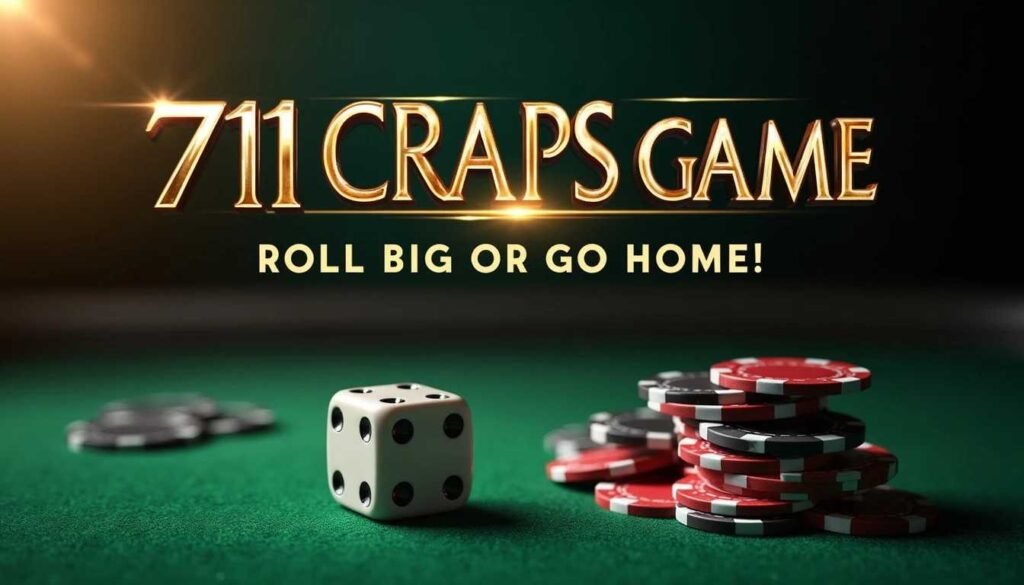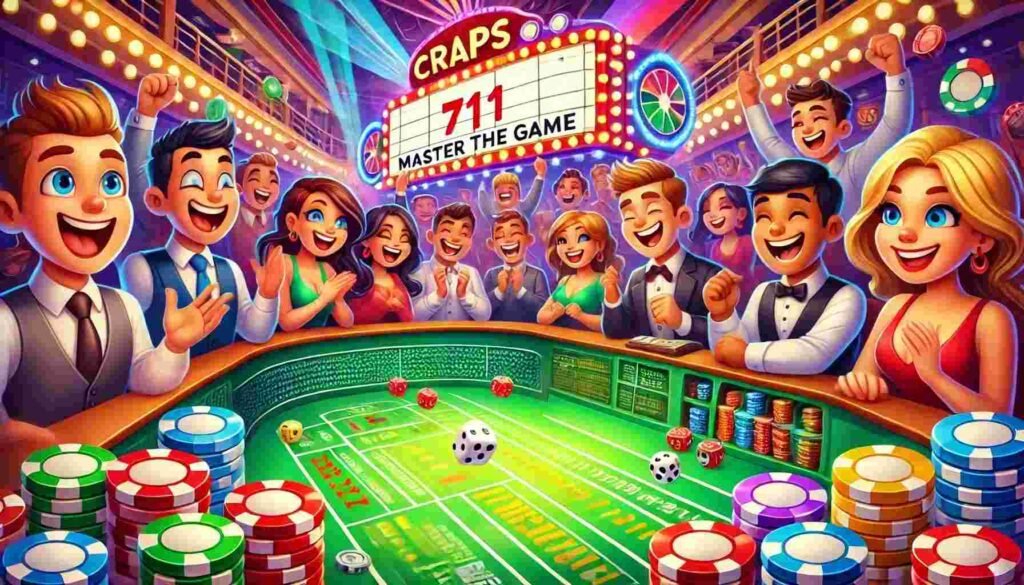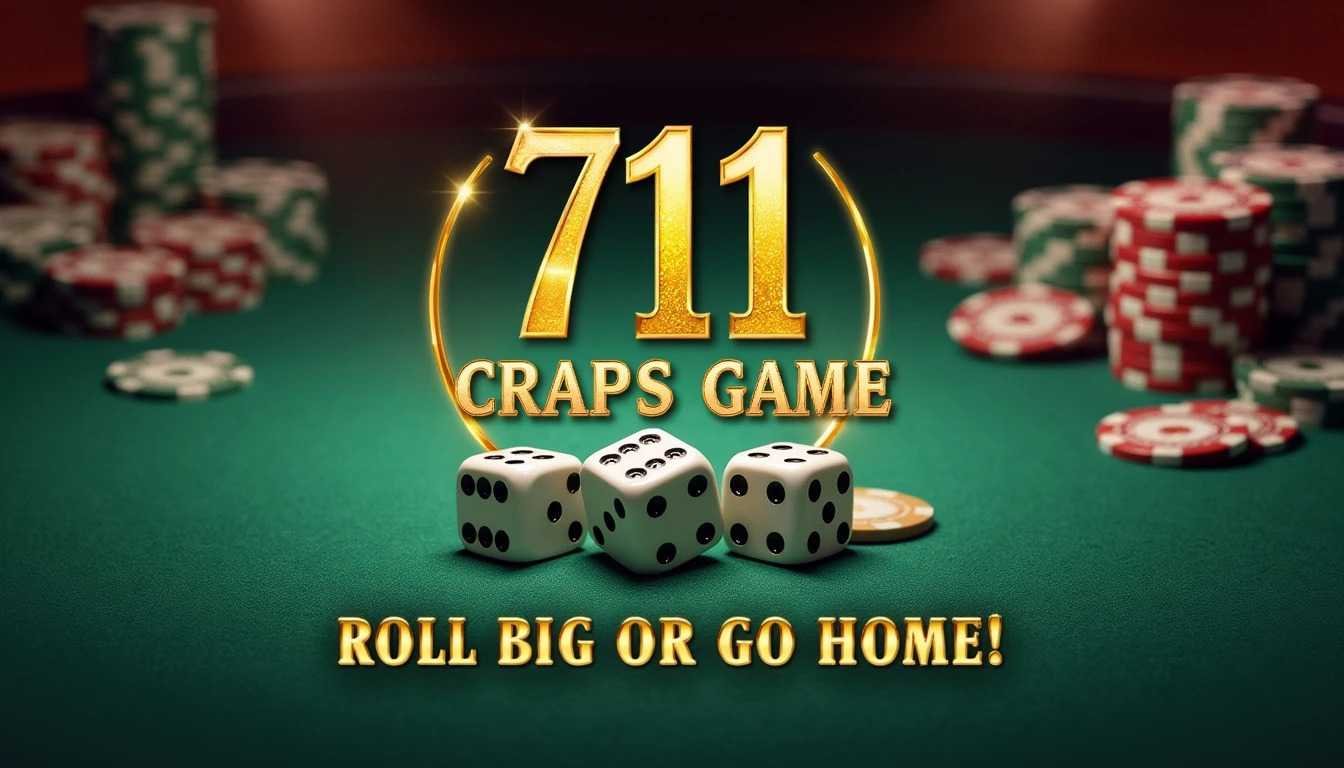If you’ve ever hung around a craps table at a casino, you’ve probably heard the shouts: “7 or 11!” Whether you’re a newbie trying to understand why everyone cheers when a 7 or 11 hits, or a seasoned player looking to refine your strategy, this guide is for you
We’ll cover the basic rules, explain how 7 and 11 affect the game, dive into betting strategies, and even explore some fun nicknames for dice rolls. So, grab your chips, and let’s dive into the world of 711 craps!
Table of Contents
What is 711 in Craps?
The Role of 7 and 11 in Craps
Craps revolves around one core concept: predicting the outcome of the dice roll. When the shooter makes their first roll in a round, known as the come-out roll, rolling a 7 or 11 has special significance.
- 7 and 11 = Instant Win (Pass Line): If the shooter rolls a 7 or 11 on the come-out roll, all Pass Line bets win immediately.
- 7 and 11 = Instant Loss (Don’t Pass): On the other hand, if you’re betting on the Don’t Pass Line (where you’re essentially betting against the shooter), rolling a 7 or 11 means an instant loss for you.
The 7 and 11 rule the come-out roll, and that’s why these numbers are so celebrated—or cursed—depending on where your chips are placed.

Breaking Down the Come-Out Roll
The come-out roll is the first roll that starts a new round. The key here is understanding what happens based on the outcome:
- 7 or 11: Pass Line bets win, Don’t Pass bets lose.
- 2, 3, or 12 (known as “craps”): Pass Line bets lose, but Don’t Pass bets either win (2, 3) or push (12).
- 4, 5, 6, 8, 9, or 10: This establishes the point, and the game transitions to the next phase, where the shooter aims to roll the point again before hitting a 7.
How to Play 711 Craps
Craps Rules for Beginners
Craps is a game that can seem overwhelming at first, with its crowded table and jargon-filled shouts. But don’t worry—it’s actually much simpler than it looks. Here’s a quick breakdown of the essential rules:
- The Come-Out Roll: The shooter rolls the dice, aiming for a 7 or 11 for an instant win on the Pass Line or a 2, 3, or 12 for an instant loss (known as “crapping out”). If any other number is rolled, this becomes the point.
- Point Phase: Once a point is established, the shooter keeps rolling the dice until either the point or a 7 is rolled.
- If the point hits again before a 7, Pass Line bets win.
- If a 7 comes up first, Don’t Pass bets win, and the round ends.
Making Bets in Craps
- Pass Line Bet: This is the most common and beginner-friendly bet. You’re betting that the shooter will either roll a 7 or 11 on the come-out roll or will successfully roll the point before a 7.
- Don’t Pass Bet: Here, you’re betting against the shooter. You want them to roll a 2 or 3 on the come-out roll, or hit a 7 after a point is established. A 12 results in a push.
How to Win with 7 and 11 in Craps
Capitalize on the Come-Out Roll
The come-out roll is the most critical moment for making money with 7 and 11. Since a 7 or 11 means an immediate win for Pass Line bettors, it’s a good idea to place higher bets on the Pass Line during the come-out phase. If you’re confident the shooter is on a hot streak, this is where you can clean up.
But beware, Don’t Pass bettors! A 7 or 11 here means an instant loss. To offset this, some players hedge their bets by also placing proposition bets (more on that in a minute) that could pay off even if a 7 or 11 hits.
Betting Against 7 and 11
For those who prefer the contrarian approach, betting on the Don’t Pass Line can be highly rewarding. By doing so, you’re betting that the shooter won’t roll a 7 or 11 on the come-out roll, and that they’ll roll a 7 after the point is established. This strategy is often called playing the “dark side,” and while it may not be as popular at the table, it can be a powerful approach in certain situations.
Advanced 711 Craps Strategies
Maximizing Winnings on the Come-Out Roll
Experienced players often take advantage of the come-out roll by betting larger amounts on the Pass Line and backing it up with Odds Bets. Odds Bets are placed behind the Pass Line and give true odds with no house edge—making them one of the smartest bets in the casino once the point is set.
Playing the “Dark Side” (Don’t Pass Line)
The Don’t Pass strategy is less popular, but it can be highly effective. Here, you’re betting against the shooter, hoping for a 7 after the point is set. This strategy tends to work best when the table is cold, and the shooters can’t seem to avoid rolling a 7. While it might not be the most exciting or crowd-friendly strategy, it’s all about patience and managing your bankroll.
Common Mistakes When Betting on 7 and 11 in Craps
Overbetting on 7 and 11
One common trap for beginners is overbetting on 7 and 11, especially when they see a hot streak. While these numbers are great on the come-out roll, once a point is set, rolling a 7 can lead to instant losses on the Pass Line. Avoid dumping all your chips on one roll—spread out your bets to reduce risk.
Not Understanding the Odds
Craps is a game of numbers, and understanding the odds is critical to avoiding unnecessary losses. While a 7 or 11 may feel like lucky numbers, the odds of rolling a 7 on any roll are 1 in 6. Once the point is established, the game becomes all about rolling that number again before a 7. Knowing when to bet big—and when to pull back—can make all the difference.

Nicknames for Dice Rolls in Craps
Craps is a game full of colorful slang and nicknames, especially when it comes to dice rolls. Using these terms adds to the camaraderie at the table and the overall excitement of the game.
- Snake Eyes (1-1): A roll of two 1s, resembling the eyes of a snake.
- Australian Yo (1-2): A roll of 3. Called “Yo” because 11 (on the reverse) is referred to as Yo-leven, and “Australian” because of the “down under” idea of opposite dice faces.
- Little Joe from Kokomo (1-3): A roll of 4, likely named after a legendary gambler or folk character.
- No Field Five (1-4): A roll of 5. This number doesn’t win on Field bets, hence the name.
- Easy Six (1-5): A roll of 6 made with 1 and 5, considered “easy” since it’s not a hard six (3 + 3).
- Six One You’re Done (1-6): A roll of 7, signaling the end of the round for many bets, hence “you’re done.”
- Ace Caught a Deuce (2-1): A roll of 3, where “Ace” (1) pairs with “Deuce” (2).
- Ballerina (2-2): A roll of two 2s, sounding like “tutu,” hence the playful nickname.
- The Fever (2-3): A roll of 5, often tied to the excitement or “fever” at the table.
- Jimmie Hicks (2-4): A roll of 6. The term “Jimmie Hicks” is often used for a hard six, but its origins are unclear.
- Benny Blue (2-5): A roll of 7, though the exact origin of this nickname is uncertain.
- Easy Eight (2-6): A roll of 8 made with 2 and 6, considered “easy” because it’s not a hard eight (4 + 4).
- Easy Four (3-1): A roll of 4 made with 3 and 1, hence an “easy” roll, as opposed to the hard 4 (two 2s).
- Michael Jordan (3-2): A roll of 5, named after Michael Jordan’s famous jersey number, 23.
- Brooklyn Forest (3-3): A roll of two 3s (hard 6), sometimes called “two trees.” It’s possibly inspired by the novel A Tree Grows in Brooklyn.
- Big Red (3-4): A roll of 7, commonly called “Big Red” due to the red number on the craps table.
- Eighter from Decatur (3-5): A roll of 8, popularized by the rhyme “Eighter from Decatur, County Seat of Macon.”
- Nina from Pasadena (3-6): A roll of 9, named after the rhyme “Nina from Pasadena.”
- Little Phoebe (4-1): A roll of 5, likely connected to regional slang or an old folk character.
- Lumber Number (4-2): A roll of 6, referring to the 2-by-4 lumber reference in construction.
- Skinny McKinney (4-3): A roll of 7, an old craps term that has persisted over time.
- Square Pair (4-4): A roll of two 4s, making an “8” and called a “square pair.”
- Railroad Nine (4-5): A roll of 9, possibly named after the 4-5 combination, which sounds like a .45 caliber pistol.
- Big One on the End (4-6): A roll of 10, highlighting the highest pip on the die (6).
- Sixie from Dixie (5-1): A roll of 6, adding a Southern flair with the nickname “Sixie from Dixie.”
- Skinny Dugan (5-2): Another term for a roll of 7, though the origin of “Skinny Dugan” remains unclear.
- Easy Eight (5-3): A roll of 8 made with 5 and 3, thus an “easy” eight.
- Jesse James (5-4): A roll of 9, named after the notorious outlaw, who was famously shot with a .45 caliber pistol.
- Puppy Paws (5-5): A roll of two 5s (hard 10), with the pips resembling a puppy’s paw prints.
- Yo (5-6): A roll of 11, often called “Yo” or “Yo-leven” to avoid confusion with the number 7.
- The Devil (6-1): A roll of 7, often called “The Devil” due to its tendency to end rounds.
- Easy Eight (6-2): A roll of 8 made with 6 and 2, also considered an “easy” eight because it’s not a hard eight (two 4s).
- Lou Brown (6-3): A roll of 9, though the origins of the nickname “Lou Brown” remain unclear.
- Tennessee (6-4): A roll of 10, likely named after the state because it rhymes with “ten.”
- Six Five No Jive (6-5): A roll of 11, named for the rhyme “Six Five No Jive.”
- Midnight (6-6): A roll of 12, also called “Boxcars” because the dice resemble two boxcars.
In craps, the numbers 7 and 11 are more than just lucky numbers – they can be the key to winning big on the come-out roll. Whether you’re a beginner learning the ropes or a seasoned player refining your strategy, mastering the impact of 7 and 11 in craps can elevate your game to new heights. Now that you’ve learned the rules, strategies, and even the colorful terminology, it’s time to hit the craps table and roll the dice!
FAQs About 711 Craps
What is the significance of 7 and 11 in craps?
In craps, 7 and 11 are crucial numbers, especially during the come-out roll (the first roll of a new round). If the shooter rolls a 7 or 11 on the come-out roll, it’s an instant win for players who have bet on the Pass Line. Conversely, those betting on the Don’t Pass Line will lose immediately. These numbers are a source of excitement because they offer immediate results without having to roll multiple times.
Is 11 good in craps?
Yes, an 11 is great if you’ve bet on the Pass Line! Rolling an 11 on the come-out roll is an automatic win for Pass Line bettors. However, if you’re betting on the Don’t Pass Line, 11 is bad news—it results in an instant loss. Outside of the come-out roll, 11 doesn’t play a significant role in the game, except for special bets like proposition bets where you can bet on it directly.
How Can I Increase My Chances of Winning with 7 and 11?
To increase your chances of winning with 7 and 11, focus on Pass Line bets during the come-out roll, where these numbers bring an instant win. After a point is set, add an odds bet to maximize your payout with no house edge. Avoid the Don’t Pass Line on the come-out roll, as 7 or 11 leads to an instant loss. For higher risk and reward, consider a proposition bet on Yo (11), which offers bigger payouts but lower odds. Just remember, keep your bankroll in check and don’t overextend your bets on 7 or 11 alone. Balancing risk and reward is key to sustaining success at the craps table.
